Ghettos
Origins
Contents
History
Above the Law
First Modern Ghetto
Wannsee conference-Final Solution
Lwow
Lodz
Lublin
Krakow
Warsaw
The ghetto was the Nazis supply depot that fueled their "final solution" to liquidate European Jewry. The idea that Jews should be concentrated to specific areas within a city was firmly routed in the European psyche. This was a continuing practice of governments from the 16th through 19th centuries . In that period, Jews were required to seek permission to live in certain cities and were either intentionally confined to certain walled areas or, self imposed, chose to live among brethren in a Jewish Quarter that became de rigueur in the passage of time. In either event, there was both a security issue and a commercial one that was seemingly resolved through the protection of numbers.
The medieval ghetto usually had an architectural style that was distinct from the rest of the city. That would change in the ascendant Nazi era when whole blocks in an urban area were confiscated and Jews were forced to occupy existing housing without considerations for aesthetics, life style and basic family requirements.
The genesis of the word "ghetto" originated in Venice where the word was spelled "gheto". In 1516, Jews were admitted to Venice provided that they agreed to be confined to a specific district. The Venetian island chosen had housed a copper foundry and ghetto meant "to cast metal". By the middle of the 16th century, the ghetto formula was codified in a papal bull. Its intent was to confine Jews to a specific, walled area of Rome until their conversion. A carrot and stick approach that time proved to have very limited merit.
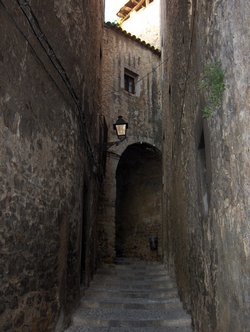 |
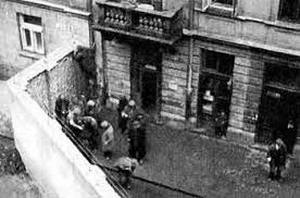 Girona, Spain Warsaw Ghetto photo by: Santi Bono www.Jewishvirtuallibrary.org |
Prelude
During the early years of the unification of German states into a single, modern nation (1871), German Jews were moving toward total integration within the general population. However, since the days of the Luther Reformation, there was always a pervasive mistrust of Jews that can be characterized as latent anti-Semitism found particularly in the ranks of the old Prussian aristocracy. This group was well situated in the halls of government and especially in the armed services. During World War 1, German Jewry was called upon to serve in the lower ranks . The only exception appears to have been in the intelligence apparatus where senior officials were sometimes Jewish. This was notably true in the Middle East where the department chief in Cairo was of Jewish ancestry. During the Nazi era, that lineage would act as a bar for service in any capacity.
During the six years prior to the invasion of Poland (1939), The Nazi government had no all-encompassing plan to cope with their Fuhrer's ideal for a Europe free of Jews. This indecision did not emanate from Hitler. In 1925, Hitler's Mein Kampf manifesto quite directly provided an overarching solution. He stated that if 12,000 Jews had been gassed, "the lives of a million decent men, who would have been of value to Germany in the future, would have been saved." Yet the Nazi bureaucracy advocated a piecemeal approach that included confiscation of assets, elimination of participation in the civil service, overt attacks on commercial interests, voluntary emigration (with loss of all assets) and forced deportation of Jews who were not German citizens and were of Eastern European descent. Deportation appears to be a central solution and ran the gamut of landing spots ranging from Siberia to Madagascar. The latter location may have been suggested by Adolph Eichmann who ultimately led the Nazis program effecting the "final solution" of the Jewish question.
The immediate pre-war years in Germany were marked with homeland violence against Jews and mainly orchestrated by the brown shirted thugs of the SA, the Storm Troopers (Sturmabteilung). Their propensity to live by the sword ultimately was their undoing. They were violently replaced as a proactive force in 1939 by the SS and relegated to training a homeguard.
In mid 1938, 32 countries met in Switzerland, under the aegis of the League of Nations, to discuss the plight of the fleeing Jews. Not one of the countries would accept a Jewish immigrant. As that year closed, the number two man in Germany, Hermann Göring, sought to encourage German Jews to migrate to Palestine. 27,000 fortunate Jews responded. He believed that Jews forced from rural areas would move to German cities and form their own enclaves--- re-instituting ghettos as such, were not planned, but concentration camps were. German Jews and political dissidents, arrested and detained, were populating the concentration camps at Dachau (near Munich,1933), Buchenwald (near Weimar,1937) and Sachsenhausen (near Oranienburg, 1938). Those "chosen" Jews were joined by Austrian Jews after the German annexation (anschluss March 12, 1938).
Reinhard Heydrich, led the German SD security forces. He supported the belief that forced emigration was the best alternative and that "ghettoizing" Jews would present a police supervision problem. (a term that would make its way into the American parlance referencing African American urban housing). In point of fact, the ghetto, after the September 1, 1939 invasion of Poland, conceptually was quite different from its earlier appearances when permanence was the motive.. It no longer merely represented a concentration of Jews. The war was a turning point and Nazi retooling was in order. Ghetto became synonymous with temporary.
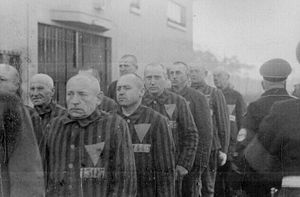
Jewish Sachsenhausen prisoners 1938 with familiar yellow triangle identification.
National Archives
As the Germans occupied Poland, claiming they needed "living space" (lebensraum), they were confronted with a Jewish population of over 3,500,000. This represented a new challenge to the Nazi, pseudo-scientific ideology of the untainted "master race" (herronvolk) and the need to preserve its purity. Heretofore, the Nazis had dealt with a miniscule German Jewish population of 500,000 when measured against a Jewish population in Europe of 9.5 million (1933). The Nazi juggernaut faced a greater challenge to their philosophy then had confronted them in the fatherland.
Initially, the Germans peeled off parts of western Poland (with many citizens of German extraction) and annexed these areas as part of a Greater Germany (Wartheland) The eastern balance of the country would be treated as occupied areas and known officially as General Government (Generalgouvernement). The latter region would redefine the modern version of the ghetto. Although used sparingly in the annexed areas with emphasize on extremely temporary. it was an article of Nazi faith that "German" areas must be "Jewless". The new ghetto model added to the older explanation that emphasized a concentration of Jews with the new concept of liquidation.
The far eastern Polish border was also breached by the Soviet Union with the apparent collusion of Nazi Germany. This effectively, if not permanently, partitioned Poland by two foreign powers. That permitted 300,000 Jews to escape the rapidly advancing German blitzkrieg and cross into Soviet territory until the Red Army closed the border by December 1939.

Above the Law
Europe was about to learn the vocabulary of the Nazi security
apparatus. Arrest, detention, torture, intentional starvation, death by
any means without legal redress was standard operational procedure.
There was no appeal process against the most desultory acts of violence.
The Nazis police state was compartmentalized into a series of
departments that were easily identified by their acronyms all too
familiar to their victims. Their presence hovered over the ghettos and terrified their potential targets..
SS--- At the top of the Nazi security bureaucracy was the Schutzstaffel (Protective Echelon) led by a fanatical racist, Oberführer Heinrich Himmler. This organization was most responsible for the World War 2 atrocities and easily identified by its insignia. They operated the infamous death squads, Einsatzgruppen, that were mobile "hit men" that terrorized the German occupied territories. Their daily death count was preserved in the Nazi archives as a testimony to their efficiency.
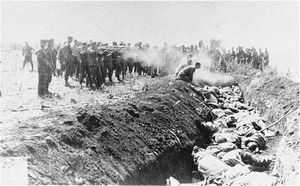 |
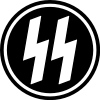 Einsatzgruppen SS (Schutzstaffel) allyoudeliverwordpress.com |
The SS organization morphed into two distinct units by 1939. The
Waffen SS were elite fighting divisions, 36 by wars end, and the
Allgemeiner SS that furnished, among other duties, the officers that
ran the concentration camps.The latter would proudly wear the Death's Head emblem that proclaimed: "My Honor's name is Loyalty".
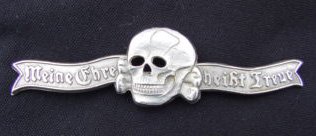
The symbols that permeated the language of the ghettos.
ZOB---Zydowska Organizacia Borjowa (Jewish resistance movement)
ZO--- Zionist Organization (proponents of emigration to Palestine)
RSHA---This umbrella security organization, Reichssicherheitspolizei, was subordinate to the SS and its major officers were from that agency. Its mission was to eliminate the enemies of the Third Reich. Originally led by Reinhard Heydrich until his death by assassination in June 1942, was succeeded by Ernst Kaltenbrunner said to be a competitor of Himmler as Hitler's favorite. He would hang for his crimes against humanity on October 15, 1946 with eleven co-defendants.
This top heavy agency amalgamated the following security organization under its aegis ostensibly to coordinate and avoid duplication:
SD and SS intelligence services (Sicherheitdienst) joined with Sicherheitpolizei,
SiPo, which in turn was made up of the Kriminalpolizei and the dreaded unit, the
Gestapo. The Geheime Staatspolizei operated 5 Departments illustrative of the width and breath of their activities. They often were most menacing when they operated in civilian attire. Their appearance in mufti was unstructured, unlike a uniformed policeman, and gave no hint to their targets of their motive.
A- political opponents
B- Sects and Churches (Jews included)
C- Administrative records of gestapo personnel
D- Occupied territories
E- Counterintelligence
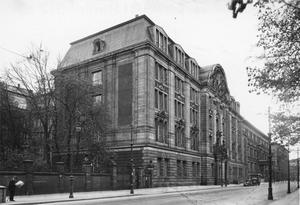
Gestapo Headquarters General Federal Archives-Berlin
The Short History of the First Modern Ghetto
There were over 1100 ghettos in Eastern bearing the stamp of the new Nazi model and about 500 in Poland. We might suspect that the German propensity for detail would have resulted in top down operational orders on the methods to gather the Jews and establish the rules for control and order. That was not the case. Factually, a vast number of ghettos were formed by reaction of German leaders on the ground, or a established by the non specific General Orders of Reinhard Heinrich --- and fill in the blanks.
Within
five days of the invasion of Poland. on September 5, the Wehrmacht
entered the City of Piotrkow Trybunalski, a 400 year old community and home
for some very orthodox Jewish families, the Chassidic Jews. They had
survived through the pogroms of earlier centuries and even the
auto-de-fe in 1663 (burning of heretics).In 1939, they were involved in a thriving, commercial life and regularly produced biblical scholars. Their religious life centered about their Great Synagogue.
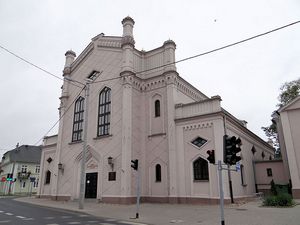
The city is located in the region that the Nazis annexed as Greater Germany (Reichgau Wartheland) in western Poland and distinct from what would was considered, in the east, occupied Poland ( known as General Government). This would be the location of the first model of a modern ghetto. The distinctions with the ancient ghetto are immediately apparent. One envisioned short term occupation as against long term concentration of Jews. The Nazi template sought to extinguish its occupants rather than allowing it to flourish.
A Nazi, civilian administrator
immediately began a plan for all Jews to occupy a specified area. It
meant squeezing 20,000 Jews into a space that held 6,000. It rapidly
extinguished the vibrant commercial life of the community. Food
shortages were the
most immediate problem for the inhabitants and sustaining life was the
greatest preoccupation. The curfew would exacerbate the situation. It
cut the
time for foraging in areas that conflicted with the Christian
population also feeling the pinch of shortages.
This ghetto was unfenced and delineated by surrounding signs. Its official opening was October 8, 1939,
but the requisite number of occupants was not filled for two months.
This despite that the Jews were given 3 days notice to vacate their
current homes on the penalty of death and summarily shot those too
ill or old to move. It is estimated that 1000 infirm were murder
victims and rapidly dispatched.
Local administration of the
ghetto was delegated to the Judenrat (Judenraete), a council of Jewish
elders approved by the Nazi to effect their orders. This became a
constant fixture in the future ghettos. It also was a potential source of
conflict with its occupants who saw the council members as extensions
of Nazi brutality. At a latter time, in the infamous Warsaw ghetto, the
council leader would commit suicide to avoid carrying out Nazi
directives intended to transport Jews to death camps.
Jews
expelled from other locations (Warsaw, Lodz) constantly augmented the
declining numbers of inhabitants lost to starvation and disease. The
Nazi system employed in the liquidation of ghettos was to strike
suddenly and calculated to surprise unsuspecting Jews. The SS often
struck on Jewish holy days, or as in the case of Piotrkow, they began
their round up on the night of October 13, 1942 (Yom Kippur)
and completed the liquidation on the following day. The Jews were
loaded on trains, 150 to a car, given no food or water for the several
days journey, and transported to the camps at Buchenwald, Majdanek and
Ravensbrück.Those that survived barely outlived those who died on the trains.
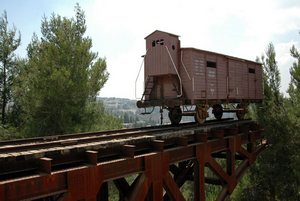
Cattle Car Memorial
3,500 Jews remained to work in the city's factories. By 1944 only 1000 were found alive. In 1953, the census records the presence of 200 Jews. The connection between ghetto as a pipeline and liquidation was closed.
Final Solution/Wannsee Conference
January 1942: The sheer number of Jews in the German occupied regions tested the older Nazi solutions for a Europe free of Jews. In 1938, the SA attacked German Jewish citizens and property (Kristallnacht). This was followed by pressuring Jews to migrate, forced deportations to the east and even suggestions from Hermann Göring to concentrate Jews in ghettos intended to isolate them. Reinhard Heydrich, the leader of the RSHA security systems, disputed the idea on the grounds that a greater concentration of Jews would result in a police control problem. It was apparent that the Nazis, not otherwise adverse to murder, were still debating policies that were either too slow to accomplish their ends or concluded that they required something more definitive.
A meeting was convened on the outskirts of Berlin on the shores of a rustic lake. The "whose who' of the Nazi pantheon were present: representatives of the Justice Department, Foreign Ministry, Hitler's personal office, SS, Gestapo, Reinhard Heydrich along with his appointed director of the Office of Jewish Affairs, Adolph Eichmann, as well as commanders of occupied Poland and Latvia. This meeting of Nazi heavyweights were here to rubber stamp an earlier Hitler proposal, one year before, to liquidate Jews by mass murder. Thus, the meeting was to establish an implementation plan. The "final solution" was a blueprint for genocide. There now was agreement for utilizing ghettos as a storage depot to supply bodies for liquidation in the concentration camps.
The next step was building the appropriate death camps under Aktion Reinhard plan (also known as Operation Reinhard---1942) which will be discussed in our chapter on concentration camps. However, from this time forward every Polish ghetto became a way station, a temporary stop, enroute to extermination camps.
Ghettoizing Eastern Europe
There were eleven hundred major ghettos established in Central Europe,
and all of the biggest were in Poland with its largest Jewish population
in Europe tipping the scale at five hundred. However, not every ghetto
was created equal. Housing ranged from apartment dwellings to factory
floors. Commerce ranged from centrally controlled cooperatives to
capitalism.The disparities were superficial when measured by the common
denominator that fed the Nazi ideology. Even before the "final solution"
was implemented, the target was eliminating the Jew from Europe. The
"how' was on the drawing board and resolved at the Wannsee Conference
(above). The ghetto was another term for "temporary".Below is a common sign found outside of many ghettos: "Jews are our misfortune."
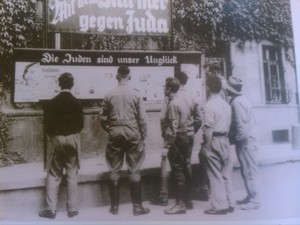
Every region occupied by the Nazis had a holding pen. The German ghetto model would be duplicated in Budapest, Hungary and remain viable into 1945. Romania would create a transit point for forced deportations to Transistria in the southern Ukraine. In Salonika, Greece, with that country's history of anti-Semitism, the ghetto had a short life span in 1943. The Baltic countries were no exception. Oddly, no ghetto was established in the Netherlands, but there was an acknowledged "Jewish Quarter" in the major urban areas.
Each ghetto presented a fight to survive. In some, it required collaboration and corruption. Smuggling, particularly for food, was always rampant. Armed revolts in a handful of ghettos were futile but full of symbolic value.
There is no definitive number of deaths exacted in the ghettos. Starvation, disease, mass murder in the streets and squares is not quantifiable. The best estimate ranges to approximately .75 million to one million Jews. Add to that 3.5 million in the camps and another 1.5 million shot at different locations. Possibly the best corroboration can be found in the dispassionate testimony of Adolph Eichmann on trial for his life in Jerusalem: 6,000,000 Jews.
The five largest Polish ghettos were Warsaw, Krakow, Lodz, Lublin, Lvov (Lwow). All, except the Lodz ghetto (in the annexed areas contiguous or near Germany), were located in the occupied regions of Poland's General Government (General Gouvernement) rather than in the annexed western territories. The history of each runs the gamut of the experiences suffered in the eleven hundred ghettos.
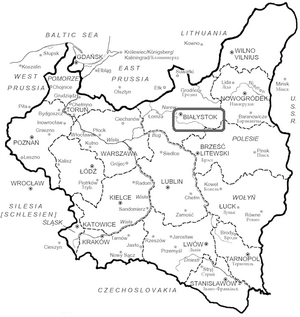
Lwow
Merely noting the variety of spelling of this Polish wartime city indicates the numerous changes of sovereignty in the southern region of Poland. In its current incarnation, the city is located in the western edge of Ukraine: Lwow (Polish) Lviv (Ukrainian) Lvov (Russian) Lemberg (German) and prior to World War 1 the province of Galicia in the Austria-Hungarian Empire.
In 1939, Lwow was the third largest city in Poland (Warsaw, Lodz). The Jewish population was about 100,000 but grew to 200,000 as the German Wehrmacht forced fleeing Jews eastward. The inflow of Jews would grow during the German occupation to about 260,000. The city fell to the Nazis on June 30, 1941after the Soviet army had abandoned it as they were driven out by the Nazi onslaught.
In the first 4 days, the German mobile death squads (Einsatzgruppen), with active participation of Ukrainian mobs, hunted, robbed and murdered 4,000 Jews. This was followed by another pogrom that disposed of 2,000 more Jews.

allyoudeliverwordpress.com
In November 1941, the Lwow ghetto was established. The German
governor for Galicia had moved all the Jews to the slum area of the city
with a single access road. On the 15th of November, a "selection" was conducted that resulted in the murder 5,000 ill and elderly.
An underground was formed primarily to aid Jews to escape. This was quite futile because of the local antipathy for Jews. Those found outside of the ghetto were shot to death. However, some Jews were fortunate to be hidden by some compassionate Gentiles. The Jews were forced to build a 9 foot fence and also had to pay for the materials. This would seal the ghetto by September 1942.
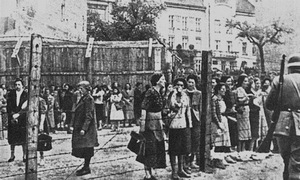
The Nazi administration immediately formed a Jewish Council (Judenrat) to execute the German orders that affected the ghetto. Primarily, the council was pressed to supply the slave laborers to operate the local munitions factories. Effectively, this spared the lives of thousands for about a year for those fortunate issued work permits.There would be an ongoing debate between Nazi officials with disparate goals---those tasked with supplying resources for the war effort and those aiming to supply bodies to transport to the death camps. The ghetto was augmented with a satellite labor/concentration camp (Janowska). Ultimately.they would all be murdered by the SS during the summer of 1942. In that year, deportation would trump all and leave barely 200 souls alive.
The Judenrat began as a organization of 1,000 Jews overseeing labor supply, housing and welfare. Ultimately the administration of 23 separate departments, ranging from hospital service (that would develop a vaccine for typhus) to soup kitchens, required 4,000 Jewish administrators. Some would be summarily hung by the Gestapo for resisting orders to supply Jews for deportation.
In the spring of 1942, the Nazis chose passover eve to raid Jewish families. Their net mostly targeted women and children. 15,000 were immediately shipped to the Belzec death camp. In June, the final liquidation of the ghetto was begun in earnest. On December 5, there was a repeat performance when the Germans burned entire streets to flush out hidden Jews and killed another 15,000 over the next month. The Judenrat was dissolved. The underground asserted itself and killed 8 gestapo agents. The Nazi murders would continue through 1943.
The remnants of Lwow, estimated at a few hundred Jews, were liberated by the Soviet Army July 27, 1944.
Lodz
Located near the western edge of Poland, Lodz fell to the German drive within eight days after the invasion of Poland. Thus, on September 8, 1939, because of its proximity to the newly established Greater Germany it was annexed and renamed Litzmannstadt. In addition to its 230,000 Jews, the city was also home to a German speaking community of 60,000. The Nazis would employ their ready assistance in the persecution of the Jews who were involved in the vibrant textile industry. This latter fact, its skilled labor force, would be a cause for contention between Armaments Minister, Alfred Speer, who valued the ghetto's high production that supplied the German military, and Himmler. The SS Oberführer intended that Greater Germany be Juden frei and that required that ghettos be temporary inconveniences and only a transit point in the liquidation pipeline.
The Jewish community was immediatly ordered to wear the yellow badge ( to be replaced by the Jewish star) and their Council of Elders (Altestenrat) was quickly disbanded. The council had sought to limit deportations, attempted to organize cultural events, create schools and limit confiscations. Some of the institutions would endure into 1941.
The German's current concern was the dispostion of 160,000 Jews by any means including deportation, starvation and disease. It is estmated that over 40,000 died of starvation/disease. On December 10, 1939, pursuant to a secret order, the Jews were herded into the Baluty area of the old city. The Nazi administration knew that the ghetto was "provisional" and the target was elimination of the "pestilence". The isolation was intended to be total and the ghetto was official by February 10,1940. The separation was so precise that Jews could not cross a Gentile road when marched to forced labor sites. They were forced to construct a bridge to avoid treading on a Christian street (or avoid spreading disease). On May 1, 1940, the ghetto was sealed. Before the sealing, as many one-quarter of the Jews fled east toward Russia.
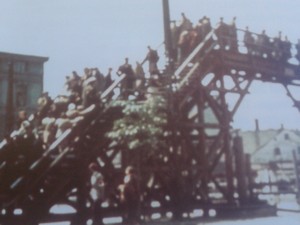
Grolier Educational
After the ghetto was sealed, the inhabitants were totally dependent on Germans for food. Shoot to kill order was in effect for anyone venturing out of the ghetto. Rations were watery soup, 1 slice of bread and horse meat sausage.Housing was a crisis with as many as 10 to a room. Sleeping shifts had to be organized and no heat was standard throughout the cold winter.
Despite re-population from areas as far away as Luxemburg, the ghetto was reduced to about 90,000 by September 1942.The SS was instrumental in supplying the death camps. Chelmno camp was only 40 miles from Lodz and operational by the end of 1941 utilizing 3 gas vans and mass graves.
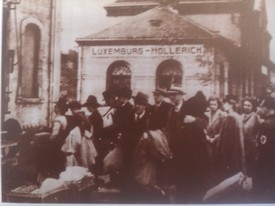 |
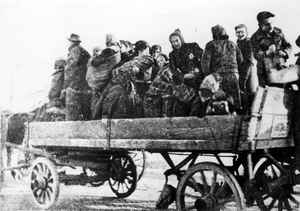 |
Grolier Educational YodVashem.org
An unusual relationship developed between the appointed Judenrat and the Nazis. Its leader was Mordechai Chaim Rumkowski and unresolved was whether he was a saint or a sinner. Unquestionably, he collaborated with the Nazis. He supplied the slave labor, he participated in the deportations but kept the large, Jewish labor force alive for years. The ghetto remained viable long after every other ghetto closed. Rumkowski supported educational institutions, but evidence is extant that he played favorites. He appointed Jewish police to control the ghetto that never had any serious resistance movement.
A survivor, Primo Levi, a Jewish novelist, commented on the foibles of man:
"We are all mirrored in Rumkowski....His fever is ours....Willingly or not we come to terns with power, forgetting that we are all in the ghetto, that the ghetto is walled in, that outside the ghetto reign the lords of death and that the train is waiting".
Levi committed suicide in 1987. (The Drowned and the Saved, Holocaust Literature, John K.Roth Editor, Salem Press, Inc. Pasadena, Cal 2008)
Below, a Jewish policeman at the ghetto entrance. www.ushhmm.gov
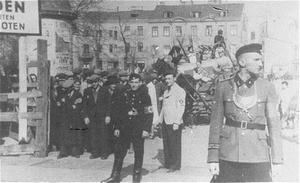
In the summer of 1944, Himmler had won the argument about liquidating the Lodz ghetto. Thousands were shipped to Chlelmno and Auschwitz where Rumkowski and his family perished. The Red Army liberated Lodz on January 19, 1945 and found 877 alive in the ghetto. It is estimated that 10,000 may have survived at different locations.
Lublin
Pre-war Lublin was the home of 40,000 Jews. Although they were not assimilated with the local Polish population, they were represented on the city council. Most spoke Polish fluently, but at home Yiddish was the lingua franca. They were part of the commercial trading class of Lublin and owned about 30% of its factories. It had been 20 years since they last experienced a pogrom and suffered the loss of four Jews.
However, all of their lives were forfeit on September 18, 1939 when the Wehrmacht entered the city. Some Jews were able to flee eastward toward the Soviet lines. However, Lublin will soon be the new home for many Polish Jews escaping the Warsaw ghetto, as well as others, because they correctly believed that food was available in Lublin----but so was infectious disease.
In less than a month, the Jews were presented with a bill of 300,000 zlotys payable immediately to the order of the Wehrmacht. That was accompanied with beatings on the streets and a requirement for all Jews to register. On October 15, 37,054 registered and ordered to wear the Jewish Star on an armband.
The appointed Judenrat continued the community control of its hospitals, orphanage and homes for the elderly. They attempted to cooperate with their masters and established a labor office (arbeitsamt) that produced 28,000 able bodied workers. That did not appease the Nazi administrators or the SS. On November 9, the first "resettlement" of Lublin Jews was ordered. In short order, the Jews were rounded up, dragged from their homes in the central city and placed into the area known as the "old city" (Jewish Quarter). In a matter of months, a Jew could not be found in the town center. The ghetto formed was far from closed and allowed the young, and the more wealthy, to escape Lublin. This was merely a warm up period that still was punctuated with looting, beatings and embarrassing Jews.
1940 witnessed the deportation of thousands of men to the Belzec labor camp where they would ultimately perish. Deportations continued without a unified end game. This would be decided at Wannsee about one year hence.
The Belzec camp was chosen by the Lublin SS police leader in 1941 as the site for mass murder by utilizing three gas vans. (See chapter on concentration camps.) There is a report of a young boy who escaped from Belzec and found his way back to Lublin ghetto and disclosed the secret of the labor camps. The response of the Lublin ghetto was denial. News of mass executions were too horrible to absorb.
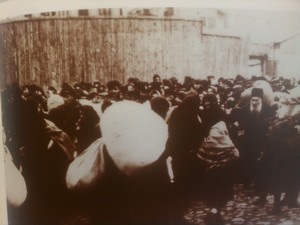
Grolier Educational
The Lublin ghetto became official on March 24, 1941. Thereafter the Nazis divided the ghetto into A and B sections separating each with barbed wire. Visits to either side required permission. The A side housed Jews who were not registered to work and immediately at risk for deportment. The B side was the smaller entity in which the Judenrat administered its labor intensive work force. The B side would undergo deportations by 1942 pursuant to the operation of the Reinhard Action designed to carry out the final solution of the Jewish problem.
In March 1942, the SS, working with their Ukrainian ally, struck the ghetto at 10P.M. The elderly and ill were killed instantaneously, all unemployed were readied for transport to Belzec, and the Judenrat was ordered to deliver 1500 individuals per day for transit. In April ,thousands of unemployed Jews (not involved in the Nazi war effort) were shipped to Belzec for extermination.
A new camp (Majdanek) was in the process of opening to absorb all Lublin B slave laborers as well as its women and children. 4,000 from the Lublin ghetto would die in this camp. . In the same month, 2,500 Jews were brought to the Krepiak Forest and shot to death. The last mass murders were committed within hours of the arrival of liberating Soviet forces in July 1944.
The Lublin ghetto experience: 30,000 murdered. A Lublin survivor, 8 year old Nechama Bawnik, recalls how her father, Roman, hid the family, wife and 2 children, in a factory once owned by him, and with the help of its current German manager. Thereafter, the family was separated when she was given refuge with a Polish Christian family and false identification papers declared her a Catholic. She recollects having to learn Catholic prayers to support her identity. The family was reunited and fled to Warsaw again with false identity documents. The sisters were again placed with Polish Christians and posed as their nieces.
Nechma spent sometime with her old tutor in the Warsaw ghetto. One night she heard shooting in the street. A Nazi raid was in progress. She recalls evading the soldiers to escape the ghetto. She has a vivid recollection of seeing babies shot in their carriages. The family again fled to the city of Kliece and once again was befriended by a Polish family (the Homar's). There this young girl illegally sold rolls baked by her mother in the black market and ran into the Gestapo. She escaped and hid in a nearby field. This was her life until liberation by the Soviet Army in 1945.
The family returned to Lublin to find their home wrecked.Three Jewish families had survived. She has spent her adult life in the United States, a graduate PhD in sociology from Columbia University. (Dry Tears:The Story of a Lost Childhood, Wildcat Publishing, Westport, Ct 1982.)
We reviewed (above) the establishment of the first Nazi model of the modern ghetto in Piotrkow Trybunalski. In Lublin , we note, that this ghetto holds the unenviable title as the first ghetto in the General Government region to be liquidated.
Krakow
When the German army marched into Krakow (also Cracow), there immediate target was its 56,000 Jewish population. They had been a fixture in this ancient capital of Poland since the 14th century. Most were working in the garment and food industries. The medical and legal fields were dominated by Jewish professionals. There was a vibrant cultural life and several daily Yiddish language newspapers were published. In this environment, the Germans declared the city as the capital of the General Government territories. It also was an open season to loot all Jewish property, "Aryanize" all Jewish business. As would become commonplace, the Ukrainian collaborators (Ukraine Volksdeutsche) were on the scene to supplement the Nazi effort.
Those Jews with the courage , and often financial resources, fled to Galicia, then occupied by the Red Army. For every citizen who escaped, they would be replaced by Jewish refugees flocking to the city from more westerly areas. A German census in November set the Jewish population at 64,428-----actually 80,000 was closer to the mark. On December 1, 1939, it was mandatory for all Jews to wear the Blue Star of David on the right arm. They were forbidden from main streets except to clean them (May 1940). Grolier Educational
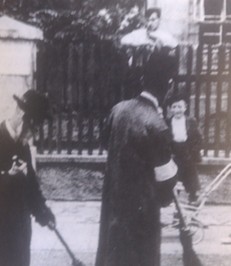
By mid May, the Nazi administrator decreed that only 15,000 "productive" Jews would be allowed to remain in the city. Those without work permits were to be deported forthwith. The appointed Judenrat was ordered to implement the policy but 70,000 still remained after two months. The balance of the year the Nazis devoted to finding and deporting Jews. They were aided by Polish auxilliary police. In January 1941, several Jewish dignitaries and Rabbis appealed to the Catholic cardinal for relief. When the Nazis learned of this appeal, the appellants were immediately deported to their deaths in Auschwitz.
Two months later, the ghetto operation was announced and required total compliance with relocation by April 20. The area, once the city slum, was enclosed with a wall and barbed wire. The seal was incomplete as many services were outside the enclosure including medical and factories requiring Jewish labor. This was also an invitation for smuggling in food to augment the daily ration of 250 calories allotted each Jew. The one day passes were life savers. By October, the penalty for being caught without a pass was immediate death. This also applied to Poles who harbored Jews.
By the end of 1941, 3000 Jews were deported but were replaced with 6,500 from surrounding villages. Implementation of the new Aktion Reinhard plan would set the stage for deportations in 1942.
By summer, 5000 Jews were deported to Belzec. The extermination apparatus was operational since March of 1942. In October, rumor of a new round of killing and deportations sparked the futile attempt of ghetto residents to hide. Hundreds had already been shot in the streets and another 5000 were deported. This was also a call for resistance. Youth groups (ZOB formed in many ghettos) organized a committed acts of sabotage in Krakow and killed several German soldiers. On December 22, they attacked Germans in a cafe and killed between 7 and 11 soldiers. Jewish collaborators may have informed leading to capture and killing of the resistance fighters.
At this time, the SS had reduced the size of the ghetto significantly. They used the Lublin model and divided into A and B. Workers and Non-workers (no labor permit) were separated by barbed wire. The A work force was moved to a nearby work camp established at Plaszow. They were no longer paid their miniscule salary and their forfeited pay went into the coffers of the SS. There were several factories adjacent to the labor camp(s) that included a Siemens plant as well as the famous factory of Oskar Schindler, the State of Israel designated "Righteous Man".
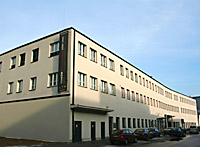
During June of 1942, 7000 deportees were sent to Plaszow merely as a pit stop. They were quickly transferred to Belzec with the usual consequences in that death camp. The SS was now planning to liquidate the ghetto pursuant to the orders of Himmler. During March 1943, the SS and police shot 2,000 individuals in the ghetto and shipped the Judenrat concil along with about 2,000 Jews to the labor camp at Plaszow---some included the Schindler Jewish workers whose facility had been moved near the camp. Additionally, 3,000 were deported to Auschwitz-Birkenau where unexpectedly 499 were "selected" out and spared.
Several Jewish revolts (Warsaw--April/May 1943, Treblinka death camp--August 1943, Sobibor death camp--October 1943) prompted a spate of SS killings in the Krakow and Plaszow areas. It is estimated about 9,000 died between September and December 1943.
Krakow was liberated by the Soviet Army January 19, 1945. Several thousand Jews returned to the city but would suffer, again, a pogrom. They got the message. By the mid 1990's only a few hundred remained.
Warsaw
Warsaw, the capital of Poland, was home to about 378,000 Jews on the eve of World War 2. Their history there was somewhat ambivalent. In World War 1 they had been subjected to pogroms by Russian troops and their existence with the Polish was always problematic. They had maintained a full complement of cultural,religious and educational institutions. Almost as soon as the German invasion began, the city was heavily bombed, and as the Germans advanced, cannon fire decimated the city. A goodly number of Jews, particularly many community leaders, fled the city. On September 28, 1939, the city surrendered.
The orthodox, Jewish community was immediately identifiable by their distinctive black clothing and beards. The Germans were particularly hard on those individuals. They were abused verbally and physically. That was only a down payment on the future for the Jews in Warsaw.
The German military was replaced by a civilian administration, but the SS were independent participants. As became increasingly the modus operandi of the Germans when they established a ghetto, they authorized the formation of a 24 man Jewish Council (Judenrat) to be run by an engineer, Adam Czerniakow.
Students of the Shoah will always debate whether he was a collaborator or merely acceded to the obvious power of the Nazi masters. He kept a diary that easily can be an admission of double dealing. The decisions he made ultimately created dissatisfaction with the Council. There were charges of favoritism. The Council often chose the weakest for labor details. Although he manged several departments (welfare, cultural, religious, education, public works , health), as far as the Nazis were concerned his real duty was to supply individuals for deportation and daily labor assignments at miniscule wages. The latter workers were paid by the Council from revenues collected from the wealthier ghetto residence.The Council, itself,would employ as many as 6,000 Jewish workers.Did he understand that the Nazi call for forced laborers for deportation directly led to their murder? Probably. When the ill or elderly were "selected", he must have realized that the call for workers was a weak subterfuge. In 1942, when the Nazi selection included children, Czerniakow committed suicide.
As 1939 closed, Jews were seized on the streets, wearing the Star of David was mandatory, confiscations were constant, and they were mandated to wear the white arm bans with the Blue Star of David. By the spring of 1940, nine foot ghetto walls were being constructed to isolate a growing population of 400,000. A strange anomaly divided the ghetto into two parts. A major Warsaw Street bisected the ghetto creating a large ghetto to the north and a smaller one to the south. Owing to the exclusion of the Jews from that street, a wooden foot bridge straddled the street connecting each of the ghettos.
By November, the ghetto was sealed but porous enough for smuggling. Food was the major item. Each Jew had been allotted a ration equal to 184 calories as versus the outside of over 2600 calories. It is estimated that 80% of the food consumed came through holed bored through buildings on the periphery and through the city sewers. Orders to shoot to kill any Jew outside the wall without a valid permit came directly from the office of the Governor, Hans Frank (October 15, 1941).
Half the ghetto had sunk into poverty and soup kitchens were set to meet basic needs. Overcrowding was an understatement. Sheer numbers relegated 6 persons per available room. Radios were outlawed. The Final Solution was still one of many alternatives. Signs were erected warning the general population that the ghetto carried infectious diseases. Jews with the right to work outside the walls were subject to a 7P.M. curfew.
In 1941, 65,000 workers labored in workshops in and outside the walls. For many, work was just a meal. Between this year and the next, the monthly death toll topped 5,000. A telephone line was allowed for the Council offices. One street car was allotted bearing the Jewish Star. Orders were broadcast over loud speakers.
During the summer, 10,000 young men were sent to labor camps. Nevertheless, the SS, now in charge of the ghetto, continued raids to augment the labor pool. In addition to the general population, only 70,000 men between 20 and 49 remained behind the walls. Women numbered 107,000. That winter the Jews were ordered to turn over all furs and blankets.
The Germans directed Czerniakow to form a police service, Jewish Order Service was formed. Its leader, a Jew converted to Catholicism, Jozef Szerynski, who proved to be thoroughly corrupt and a puppet of the Germans .In August 1942, the ZOB underground attempted to assassinate him--only wounded (later committed suicide). During his reign, he was charged with supplying guards for the walls, keeping order, and general sanitation duties. The service would employ 2,000 and similar to the duties of Jewish police in other ghettos. The force was supposed to operate under the Judenrat's jurisdiction but essentially became independent. This "blue police" were deeply involved in smuggling. Its members believed that as part of their security duties they would be immune from labor details and from deportation. That would change within a year. Their involvement in the deportation process, supplying a required quota to save their own families, gained them the enmity of the ghetto and particularly the ZOB underground organization.
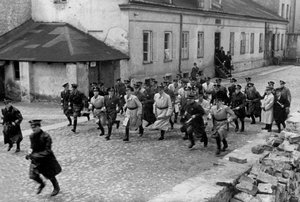
HolocaustResearchProject.Org
January through March 1942, news of mass killing in Lodz and Lublin filtered into Warsaw. Community leaders vetoed organizing a defense. The militant ZOB disseminated flyers describing the transports to Treblinka. At the end of July, the SS with the aid of Ukrainians and Latvians began a sweep of the ghetto streets piking up Jews for deportation. Aktion Reinhard was in full swing. The little ghetto was evacuated and street life in the ghetto ended. Over the next two months, 265,000 were transported to their death in Treblinka. The remnants of the Jewish police force and their families were included.11,000 were sent to labor camps. By September 1943, large parts of the ghetto were restored to the Aryan side of the wall leaving 35,000 with valid work permits and 20,000 illegals hiding. Himmler visited the scene and was upset to learn that complete liquidation had not been accomplished. Now the Germans made an effort to find those in hiding. They were met with a fusillade from ZOB snipers and the newer Jewish Fighting Union (ZZW) who had obtain some weapons from Polish communists. Nevertheless, the sweep netted another 5000 and 1700 killed in the streets.
The ZOB published the following manifesto:
On January 22 1943, six months will have elapsed since the start of the deportation from Warsaw. We all remember those harrowing days in which 300,000 of our brothers and sisters were transported to and brutally murdered in the Treblinka death camp.
Six months of constant fear of death have passed without our knowing what the next day will bring. We received reports left and right about Jews being killed in the Generalgovernment, Germany and other occupied countries.
As we listened to these terrible tidings, we waited for our own turn to come – any day, any moment. Today we must realise that the Hitlerian murders have let us live only to exploit out manpower, until the last drop of blood and sweat, until our last breath.
We are slaves and when slaves no longer bring in profits they are killed. Each of us must realise this, and always keep it in mind. Jewish masses, the hour is drawing near. You must be prepared to resist, not give yourself up to slaughter like sheep. Not a single Jew should go to the railroad cars. Those who are unable to put up active resistance should resist passively, meaning go into hiding.
We have just received information from Lvov that the Jewish Police there forcefully executed the deportation of 3,000 Jews. This will not be allowed to happen again in Warsaw. The assassination of Lejkin demonstrates that.
Our slogan must be: All are ready to die as human beings.
The
Jews began to systematically stock bunkers with food, molotov
cocktails, and small arms. Several of the members of the ZZW had prior
military in the Polish army.The bunkers were clandestinely hooked to the
electric and water lines. They could communicate through the sewers.
Between the ZOB and the ZZW who had acquired some arms from Polish
communists there was a total fighting force of 750. In addition
thousands of non combatants had been assigned to the hidden bunkers.
On April 19, 1943 (Passover eve), the Germans entered the ghetto in force. The
Germans began to burn the buildings fearful of entering them. They
ordered cannon to bombard the houses. The fighters kept moving between
the bunkers harrassing the German ground forces. They mad their last
stand at the command bunker at 18 Mila Street. The Germans attempted to
dislodge them by pumping gas into the bunker. For 27 days they had
withstood the might of the German army. Some were able to escape through
the sewers and join partisans in the forests near Warsaw. Twenty thousand who hid on the Aryan side of the wall with false identities, protected by Polish good samaritans, would also be victims during the general Polish uprising as Soviet troops made no effort to save them.
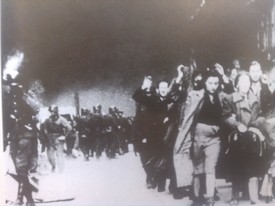 |
 |
An embarrassed General Stroop rendered this "situation report" referring to phantom "bandits": (shoah Resources)
"When we invaded the Ghetto for the first time, the Jews and the Polish bandits succeeded in repelling the participating units, including tanks and armored cars, by a well-prepared concentration of fire. ... The main Jewish battle group, mixed with Polish bandits, had already retired during the first and second day to the so-called Muranowski Square. There, it was reinforced by a considerable number of Polish bandits. Its plan was to hold the Ghetto by every means in order to prevent us from invading it. ... Time and again Polish bandits found refuge in the Ghetto and remained there undisturbed, since we had no forces at our disposal to comb out this maze. ... One such battle group succeeded in mounting a truck by ascending from a sewer in the so-called Prosta [Street], and in escaping with it (about 30 to 35 bandits). ... The bandits and Jews – there were Polish bandits among these gangs armed with carbines, small arms, and in one case a light machine gun – mounted the truck and drove away in an unknown direction."
______________________________________________________________
References and Sources:
Encyclopedia Britannica
Epstein, Joseph Eric, Rosen, Phili. Dictionary of the Holocaust, Greenwood Press, Wesport, CT 1997.
Halevey,Yechiam, Historical Atlas of the Holocaust, Macmillan Publishing USA, New York 1996.
Holocaust Research Project.Org
Jewish Gen.Inc. Kehila Links-
Meltzer, Milton. Rescue. Harper & Row, New York 1985
National Archives
The Holocaust. Goffrey Wigoder, Editor, Grolier Educational/Charle E. Smith Books, Inc. Danbury, Ct 1997
The Holocaust Enyclopedia. Walter Laquer, Editor, Yale University Press, New Haven, Ct 2001.
The Yad Vashem Encyclopedia of the Ghettos During the Holocaust, Guy Miron Ed, Schlomit Shulhani, Yad Vashem, The Holocaust Martyrs and Heroes Remembrance Authority, Jersalem, Israel.
American Wars > Holocaust Timeline > Ghettos
.